Sep. 10, 2025
Rolex Air-King - The Enduring Legacy of a Pursitic Classic

Marcus Siems @siemswatches
Collector, Author, Data Analyst
"An article about a steel Rolex sports collection"? Isn't that so 2020?! Well, five years ago the Air-King (among other Rolex pieces) was sold to us as the epitome of the watch you can just wear every day. The hype for Rolex watches is over, the dust has settled. Now, the important question is: Does the Air-King really deserve a rightful spot in distinguished vintage watch collections?
 The Air-King 5500, black dial, perpetual movement (with "Super Precision"), no date - the archetypical Air-King with its clean, puristic and distinguished look. Photo Goldammer Archives.
The Air-King 5500, black dial, perpetual movement (with "Super Precision"), no date - the archetypical Air-King with its clean, puristic and distinguished look. Photo Goldammer Archives.
Did you know, 2025 marks the 80th anniversary of one of the oldest collections in watchmaking. And not just any watchmaker but Rolex! At a time when the collecting landscape is shifting away from classic steel sports models it is an anniversary that kinda went unnoticed. Or would you have guessed that the Air-King - out of all the collections in Rolex's catalogue - is having a huge year?
So let us shine a spotlight on this under-represented vintage collection. A collection I have a very close relationship with as well: My first "proper" watch was a 1990s ref. 14010 Air-King with a radiant blue dial. Thus, I simply can't let this anniversary pass so silently. And isn't that also a little ironic: The marketing machine Rolex is passing on such an important milestone?***
So, in the following I want to provide a meticulous chronicle through the 80-year evolution of a Rolex centerpiece. I want to guide you through the nuanced developments and diverse iterations to celebrate its legacy and origin. This deep dive is supposed to highlight how The "entry-level" Rolex watch unfolded its enduring appeal and captured discerning vintage collectors all around the world.
 The same execution as my very first Rolex watch I ever bought - A 1990s deep blue Rolex Air-King reference 14010. Photo Goldammer Archives.
The same execution as my very first Rolex watch I ever bought - A 1990s deep blue Rolex Air-King reference 14010. Photo Goldammer Archives.
0) Pre-Air-King
Admittingly, the Air-King collection did not follow a straight path of evolution, both in marketing and in aesthetics. You may have heard before that the Air-King was born as a tribute watch. Hans Wilsdorf wanted to honor particularly British Royal Air Force (RAF) pilots during World War II. Lore says that these pilots preferred privately purchased Rolex timepieces over their military issued watches*. The idea was thus to launch "Air" themed watches to build a bridge between the two worlds. It started with Air-Lion, Air-Tiger and Air-Giant already in the 1930s - and in 1945, finally, the King of the Air arrived on the scene...
 Three examples of Rolex's Air-Tiger (left), Air-Giant (middle) and Air-Lion (right). All of these are reference 4365 from the 1940s. Photos Courtesy of Bonham's, Watch Centre, and Bonham's.
Three examples of Rolex's Air-Tiger (left), Air-Giant (middle) and Air-Lion (right). All of these are reference 4365 from the 1940s. Photos Courtesy of Bonham's, Watch Centre, and Bonham's.
Importantly, during the first years the Air-King was just a name on the dial and not an individual reference. You can find the same references that were marked Air-King also with for example "Explorer" marked dials or even without any additional lines. A practice that is "very Rolex" during the 1940s and 50s. Thus, I'll guide you through the cloudy Air-King history arranging 22 references into 7 periods. Buckle up and get ready for take off.
| Reference | Period | Movement | Dial | Features |
|---|---|---|---|---|
| Air-King Origin (1945-53) | ||||
| 4925 | 1945-53 | manual cal. 10.5 (15J), 18,000 Vph | white, Arabic Numerals, leaf/alpha hands | 34mm, Bubbleback Oyster-case, 50m WR |
| 4365 | 1945-53 | manual cal. 10.5 (17J) | "Precision", Sub-Second, leaf/alpha hands | also Air-Lion/Giant/Tiger |
| 4499 | 1946-53 | manual cal. 10.5 (17J) | "Precision", black, leaf/sword hands | "Swiss Made" on dial |
| First Automatic (1953-57) | ||||
| 6552 | 1953-57 | auto cal. 1030 (25J, butterfly rotor), 18,000 Vph | "Super Precision", alpha hands (lume), coronet logo | 1st Automatic, Oyster bracelet, 34mm Oyster case |
| The Classic Air-King (1957-89) | ||||
| 5500 | 1957-89 | auto cal. 1520 & 1530 | "Precision" (cal. 1520) or "Super Precision" (cal. 1530), alpha/stick hands (switch late 60s) | 34mm, longest running, 100m WR |
| 5504 | 1958-1964 | cal. 1530 | "Super Precision" | 36mm |
| 5501 | 1959-86 | cal. 1520 | "Precision" | 34mm, two-tone, fluted bezel |
| 5700 | 1959-88 | cal. 1525/1535 | "Precision", "Air-King Date" | 34mm |
| 5701 | 1959-88 | cal. 1525/1535 | "Precision", "Air-King Date" | 34mm, two-tone, fluted bezel |
| Gold-Plated Air-King (1960-70s) | ||||
| 5502 | 1960-65 | cal. 1530 (25J), 18,000 Vph | "Super Precision", alpha hands | 34mm, Oyster case, 40 Micron plating, 100m WR, smooth bezel |
| 5506 | 1960-64 | cal. 1530 | "Super Precision", alpha hands | |
| 5516 | 1960-65 | cal. 1530 | "Super Precision", alpha hands | |
| 5520 | 1960-70s | cal. 1520 (26J), 19,800 Vph | "Precision", stick hands | |
| Neo-Vintage Air-King (1989-2006) | ||||
| 14000 | 1989-99 | cal. 3000 (27J), 28,800 Vph | "Precision", stick hands, stick marker or 3-6-9 or Roman | 34mm, Oyster case, undrilled lugs, sapphire crystal |
| 14000M | 2000-06 | cal. 3130 (31J), 28,800 Vph | "Precision", (as above) | |
| 14010 | 1991-1999 | cal. 3000 (27J), 28,800 Vph | "Precision" | engine-turned bezel |
| 14010M | 2000-06 | cal. 3130 (31J), 28,800 Vph | "Precision", (as above) | engine-turned bezel |
| Accurate & Beefy Air-King (2007-14) | ||||
| 114200 | 2007-14 | cal. 3130 (27J, Chronometer), 28,800 Vph | "Superlative Chronometer Officially Certified", Chromalight | 34mm, beefy lugs, sapphire crystal, smooth bezel |
| 114210 | 2007-14 | cal. 3130 | "Superlative Chronometer Officially Certified" | engine-turned bezel |
| 114234 | 2007-12 | cal. 3130 | "Superlative Chronometer Officially Certified" | white gold fluted bezel |
| Modern Pilot Air-King (2016-today) | ||||
| 116900 | 2016-22 | cal. 3131 (31J, Chronometer), 28,800 Vph | "Superlative Chronometer Officially Certified", black, large 3-6-9, 5-minute numerals, Mercedes hands | 40mm, beefy lugs, sapphire crystal, antimagnetic, smooth bezel |
| 126900 | 2022-today | cal. 3230 (31J, Chronometer), 28,800 Vph | "Superlative Chronometer Officially Certified" (as above) | 40mm, crown guard |
Table 1. Overview over the Rolex Air-King references from 1945 to today.
1) Air-King Origin (1945-53)
The Original Air-King, the one that most likely wore the name first was the ref. 4365 starting in 1945 (until 1953). However, shortly after you'll also find ref. 4499 (1946-53) and ref. 4925 (1945-53) stamped Air-King. All of these were manually wound (10.5 ligne Aegler movement) watches inside a 34mm Bubble-Back Oyster case with about 50m water-resistance. These watches were intended as entry-level and were not Chronometer certified - you'll thus find the marking "Precision" over 6o'clock (with serifs).
 An example first-generation Rolex Air-King ref. 4499 in steel. These feature white dials with Arabic numerals and classically leaf (or alpha) hands. Photos Courtesy of Black Bough.
An example first-generation Rolex Air-King ref. 4499 in steel. These feature white dials with Arabic numerals and classically leaf (or alpha) hands. Photos Courtesy of Black Bough.
2) First Automatic - The Transitional Air-King (1953-57)
In 1953 we already see the first evolution of the Air-King into a different concept: The New Oyster Perpetual. Here, we'll see for the first time how the Air-King was explicitly placed at the lower end of the Rolex pricing pyramid. The Air-King was thus rebranded from the 'private pilot's watch' into the 'entry-level Oyster Perpetual'.
The Air-King ref. 6552 was the first with an automatic movement (Rolex cal. 1030). In contrast to other "Oyster Perpetuals" these Air-Kings weren't Chronometer certified and marked "Super Precision" - this detail ensured its standing as a more affordable Rolex. The ref. 6552 came in a 34mm Oyster case, now also with an Oyster bracelet, alpha hands and for the first time featured an applied Rolex coronet logo at 12o'clock.
 Placing the Air-King (ref. 6552) at the lower end of the Oyster Perpetual pricing pyramid - the entry-level OP (bottom right). It also shows that the Chronometer certification added a good 50% price increase over the "Super Precision" Air-Kings. Photo Courtesy of Uhrenkosmos.
Placing the Air-King (ref. 6552) at the lower end of the Oyster Perpetual pricing pyramid - the entry-level OP (bottom right). It also shows that the Chronometer certification added a good 50% price increase over the "Super Precision" Air-Kings. Photo Courtesy of Uhrenkosmos.
3) The Classic Air-King (1957-89)
1957 marks the start of the classic vintage Air-King era. It is the time the reference 5500 was launched - with 42 years the longest running reference in the collection. Common for the Air-King of the time was the modest 34mm Oyster case, screw-down crown (100m WR), acrylic crystal, the minimalist design and budget-friendly Rolex alternatives - in other words, the quintessential Air-King, the consistent execution of the idea laid out by the predecessor ref. 6552.
The classic Air-King was powered by the newly developed automatic cal. 1520 and cal. 1530: The 1520 (from 1957) came beating at 18,000 Vph, with 25-26 jewels and 44h power reserve, while the 1530 (slightly later) featured 19,200 Vph, 26 jewels and 42h PR. This distinction was also marked on the dial - "Precision" (cal. 1520) and "Super Precision" (cal. 1530). Interestingly, you can also find "Explorer" signed ref. 5500s ([example], [example], [example], [example], [example]). For the US market the number of jewels can be substantially lower (16/17 jewels, [Rescapement]).
 Comparing two vintage Rolex Air-King ref. 5500 - the left from 1962 with "Super Precision" (cal. 1520, alpha hands) and the right from 1970 with "Precision" dial (cal. 1530, stick hands). Photos Goldammer Archives.
Comparing two vintage Rolex Air-King ref. 5500 - the left from 1962 with "Super Precision" (cal. 1520, alpha hands) and the right from 1970 with "Precision" dial (cal. 1530, stick hands). Photos Goldammer Archives.
The reference 5500 was the centerpiece of the collections but around it Rolex established a myriad of variations bridging this entry-level Oyster-Perpetual to the remaining catalogue. If you look around you'll find a 36mm version (ref. 5504, "Super-Precision", 1958-64), a two-tone iteration with Datejust-esque fluted bezel (ref. 5501, "Precision", 1959-86), and two date-versions (ref. 5700/5701 (two-tone fluted), cal. 1525/1535, 1959-86) marked "Air-King Date".
 An US American advertisement for a ref. 5500 Rolex Air-King from 1977 (Tourneau, New York). Advertisement Courtesy of Ebay.
An US American advertisement for a ref. 5500 Rolex Air-King from 1977 (Tourneau, New York). Advertisement Courtesy of Ebay.
4) The Gold-Plated Air-King (1960-70s)
But the ultimate telltale that Rolex used the Air-King to cater to a smaller wallet size came during the 1960s... What yells "budget tolerant" as much as a gold-plated watch? It is that golden colored sign of success** that wouldn't break the bank (also Rolex [Metropolitan] and [Explorer]). The references 5502, 5506 and 5516 ("Super Precision", alpha hands) were in the catalogue between 1960 and 1965. And from 1960 well into the 1970s Rolex made the ref. 5520 ("Precision", stick hands).
 Several variations of the Rolex Air-King with gold-plated cases. Photos Courtesy of Heritage Auctions, The WatchGuy, Bonhams and Antiquorum.
Several variations of the Rolex Air-King with gold-plated cases. Photos Courtesy of Heritage Auctions, The WatchGuy, Bonhams and Antiquorum.
All these references come with cases based on the ref. 5500 case with 40 Micron plating (mostly yellow, rarely rose golden). The gold-plated cases were hereby made by Kessi Freres SA (KB hallmark in tombstone-shape) in Biel. The movement is the top-shelf Air-King "Super Precision" cal. 1530.
5) The Neo-Vintage Air-King (1989-2006)
With the start of the five-digit Rolex era in 1989, after the long reign of the 5500, the Air-King finally became an aesthetical and technical upgrade: Sapphire crystal, new caliber 3000 (28,800 Vph, hacking second, 27 jewels, 42h power reserve), and no more drilled lug holes. The ref. 14000 was the "standard" version that followed the aesthetic of its predecessor, while the ref. 14010 (1991) introduced a new/old bezel design - the engine-turned bezel is a machine-turned surface with fine grooves between polished plates indicating the hour marker.
 The new Rolex aesthetic of the 1990s: The Air-King ref. 14010 came with vibrant colors and lustrous light reflections on the mesmerizing "engine-turned" bezel. Photos Goldammer Archives.
The new Rolex aesthetic of the 1990s: The Air-King ref. 14010 came with vibrant colors and lustrous light reflections on the mesmerizing "engine-turned" bezel. Photos Goldammer Archives.
With the turn of the millenia Rolex "modified" the Air-King or rather the movement again. Between 2000 and 2006 the letter "M" was added to the the five-digit Air-King reference numbering (e.g. ref. 14000 -> 14000M). The "M" notified the customers that the design prevailed but the movements were upgraded to the cal. 3130 (28,800 Vph, 31 jewels, 48h power reserve, Parachrom hairspring). But from the technical perspective this update was only temporary...
 Rolex advertisement from around 2000. Interestingly, the ad marks a turning point not only for Rolex marketing (as concisely summarized by Nick @adPatina [here]) but also the Oyster Perpetual Air-King... Entry-level Rolex is still of highest quality: "Impurities in steel can not only compromise its toughness but can mar the effects of polishing by leaving little telltale traces [...] To eliminate this, the Oyster case of this $2,250 Air-King is made of steel classified as "904 L," the finest quality used in watchmaking [...]" Advertisement from AdPatina.
Rolex advertisement from around 2000. Interestingly, the ad marks a turning point not only for Rolex marketing (as concisely summarized by Nick @adPatina [here]) but also the Oyster Perpetual Air-King... Entry-level Rolex is still of highest quality: "Impurities in steel can not only compromise its toughness but can mar the effects of polishing by leaving little telltale traces [...] To eliminate this, the Oyster case of this $2,250 Air-King is made of steel classified as "904 L," the finest quality used in watchmaking [...]" Advertisement from AdPatina.
6) Dawn of a new era - The 1st Superlative Air-King (2007-14)
2007 marks the end of the "Precision" signature. From that moment on every Air-King now came as "Superlative Chronometer Officially Certified". But the overhaul didn't end with accuracy certifications... The new 6-digit references were the first to feature chromalight lume. The case appearance and feel was completely reworked: Heftier cases with thicker and wider lugs and a more prominent bezel.
And it's not only in the specs, the 6-digit Air-Kings are the perfect testing ground to feel the difference between neo-vintage and modern. If you'd handle a ref. 14000M versus a newer ref. 114200 - maybe only one year apart in production - and close your eyes you wouldn't expect those to come from the same brand, let alone the same collection. The 6-digit Air-King is heftier and sturdier, it is in every sense solid!
 Comparing Rolex's first 6-digit Air-King models: ref. 114200 (left), 114210 (middle) and 114234 (right). You can already see how the appeal of these pieces changed to the neo-vintage 5-digit models. Photos Courtesy of Bulang & Sons, Sotheby's, Zeitauktion.
Comparing Rolex's first 6-digit Air-King models: ref. 114200 (left), 114210 (middle) and 114234 (right). You can already see how the appeal of these pieces changed to the neo-vintage 5-digit models. Photos Courtesy of Bulang & Sons, Sotheby's, Zeitauktion.
Interestingly, the accuracy evolution came with on the back of the already established caliber 3130, the very same movement that powered the predecessor. The bracelet enhanced the new feeling you got from these pieces as the links were for the first time completely solid.
You can find three distinct references in that lineup, defined through their bezel style: Ref. 114200 (smooth bezel), ref. 114210 (declined engine-turned bezel), ref. 114234 (white gold fluted bezel, Datejust style). However, as extreme as these changes may appear to the trained eye (and hand) they didn't mark a redirection of the collection within the Rolex catalogue but much rather a Genevan brand that reinvented itself! And as different as they may seem to the Air-Kings of the last Century, these three references were the last "real" Air-Kings...
 When you're comparing the first automatic Air-King (left, ref. 6552) and the "last real" Air-King (right, ref. 114200) you can see the differences but the spirit of the collection endured. It is a story of time. Photos Courtesy of Monaco Legend Group and Bulang & Sons.
When you're comparing the first automatic Air-King (left, ref. 6552) and the "last real" Air-King (right, ref. 114200) you can see the differences but the spirit of the collection endured. It is a story of time. Photos Courtesy of Monaco Legend Group and Bulang & Sons.
7) The New-Old Air-King (2016-today)
It's hard to keep my personal views out of this... but the Air-King collection was discontinued in 2014, period. What came after that - starting in 2016 - was something but not really an Air-King. Anyhow, Rolex coined the "Air-King" ref. 116900 (2016-22) and ref. 126900 (2022-today) as the aviation equivalent to the Explorer I (land) and Yacht-Master (sea) (see [Rolex]).
What in theory makes sense comes with a 180 in design. The modern "Air-King" comes in a beefed up 40mm case, antimagnetic soft-iron caging of the movement (caliber 3230), a black dial with five-second increment markers, Mercedes-style hands and crown-guards on the newest iteration... Actually, it is a GMT-Master without GMT complication and thus somewhere in between collections. When marketing rewrites history. Although...
You either love or hate the modern Rolex "Air-King". It is branded as an homage watch to classic aeronautics and comes with a name that carries a lot of weight in the Rolex community. But can the design actually deliver on what it's supposed to pay homage to? Video Courtesy of Rolex.
Conclusion: What to make of the Air-King today
You and I can go on about the modern design of the "Air-King" as long as we want but I think, in a sense, it comes full circle to the original ref. 4925 of the 1940s. Because - and if we're honest - already the first Air-King signed watches were honoring pilots. They were tribute watches and never actually meant to be worn during flight. In that sense the modern interpretation is closer to the core than the most "classic" ref. 5500 Air-King. Thus, what makes the quintessential Air-King?
 The classic Air-King look and feel but in a larger frame. The ref. 5504 came with the larger (but Rolex typical) 36mm case diameter. Photo Courtesy of Oliver & Clarke.
The classic Air-King look and feel but in a larger frame. The ref. 5504 came with the larger (but Rolex typical) 36mm case diameter. Photo Courtesy of Oliver & Clarke.
I'd argue the essence of the Air-King is a timepiece that aspires to be more than it is supposed to be. It is an entry-level offering marked with "Precision" and a name that promises the world. In a sense, this is the spirit of Rolex and Hans Wilsdorf. The Air-King is a Rolex through and through.
In 2025, a model like the 5500 or the 6552 gives you not just a solid watch but also a wonderful story. We don't wear watches to tell the time. We wear them because these mechanical trinkets represent something beyond functionality... a raison d'etre of subjective significance.
So do you still wonder whether the Air-King deserves a rightful spot in distinguished vintage watch collections?
 I'm finishing this off with a wonderful 1972 Rolex Air-King ref. 5500 with a silvery linen dial. Photo from Goldammer Archives.
I'm finishing this off with a wonderful 1972 Rolex Air-King ref. 5500 with a silvery linen dial. Photo from Goldammer Archives.
Footnotes
* There are several other great guides and introductions on the Air-King over the years: [rescapement], [Bob's Watches], [Robb Report], [Time & Tide], [Monochrome Watches], [Uhrenkosmos (German)]
** But as is typical Rolex there seem to be extremely rare iterations of the ref. 5500 in solid 14k yellow gold (probably US market only) during the 1970s ([Antiquorum]). Similarly, 9k gold examples (most likely GB market only) are floating around as well ([here]).
*** Well, they might pass on it for now as the Datejust is sharing the anniversary and just got its own spotlight and book (the 2nd Rolex history written by Nicholas Foulkes).
All Rights on the text and graphics reserved to the Author.




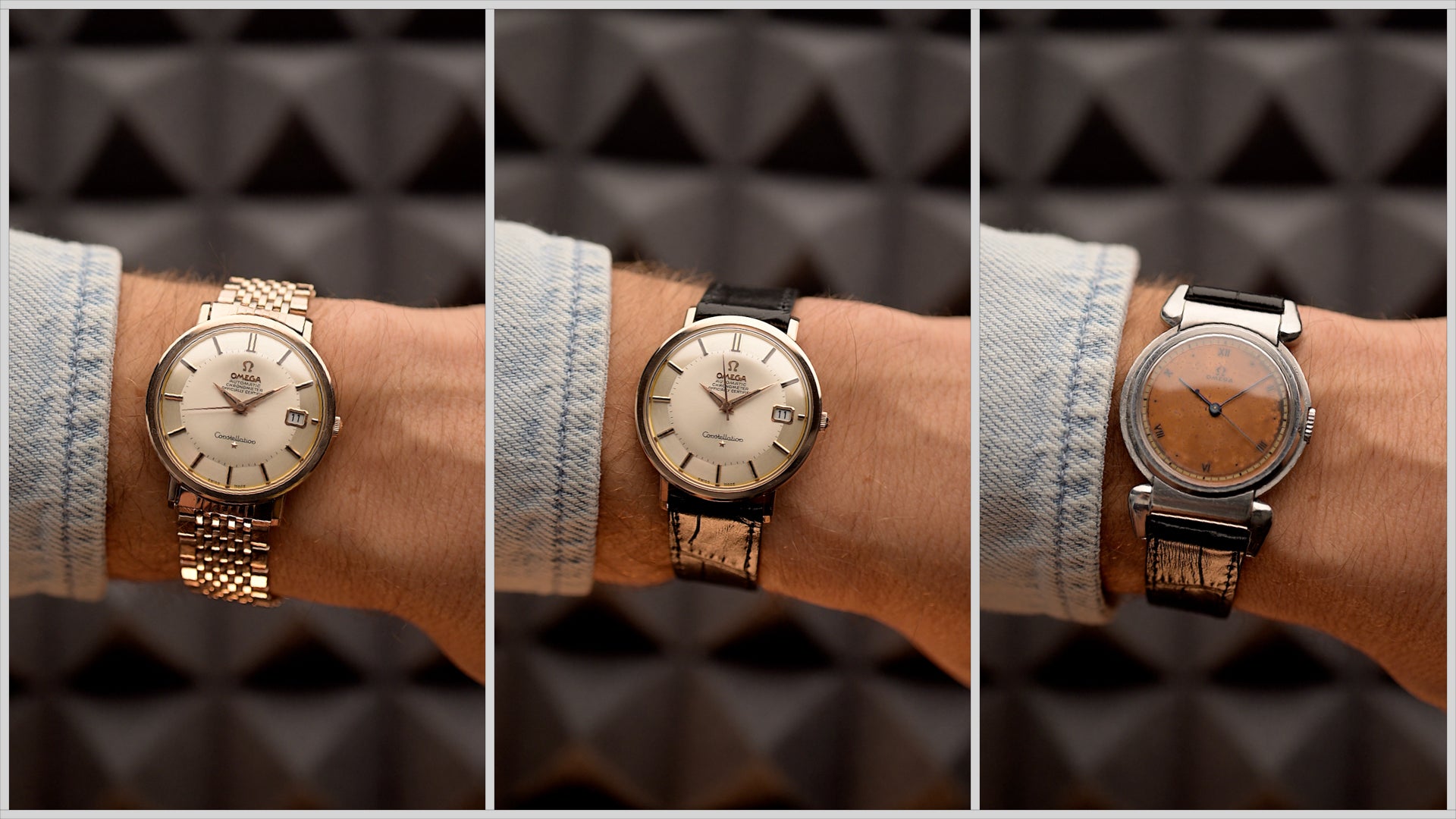
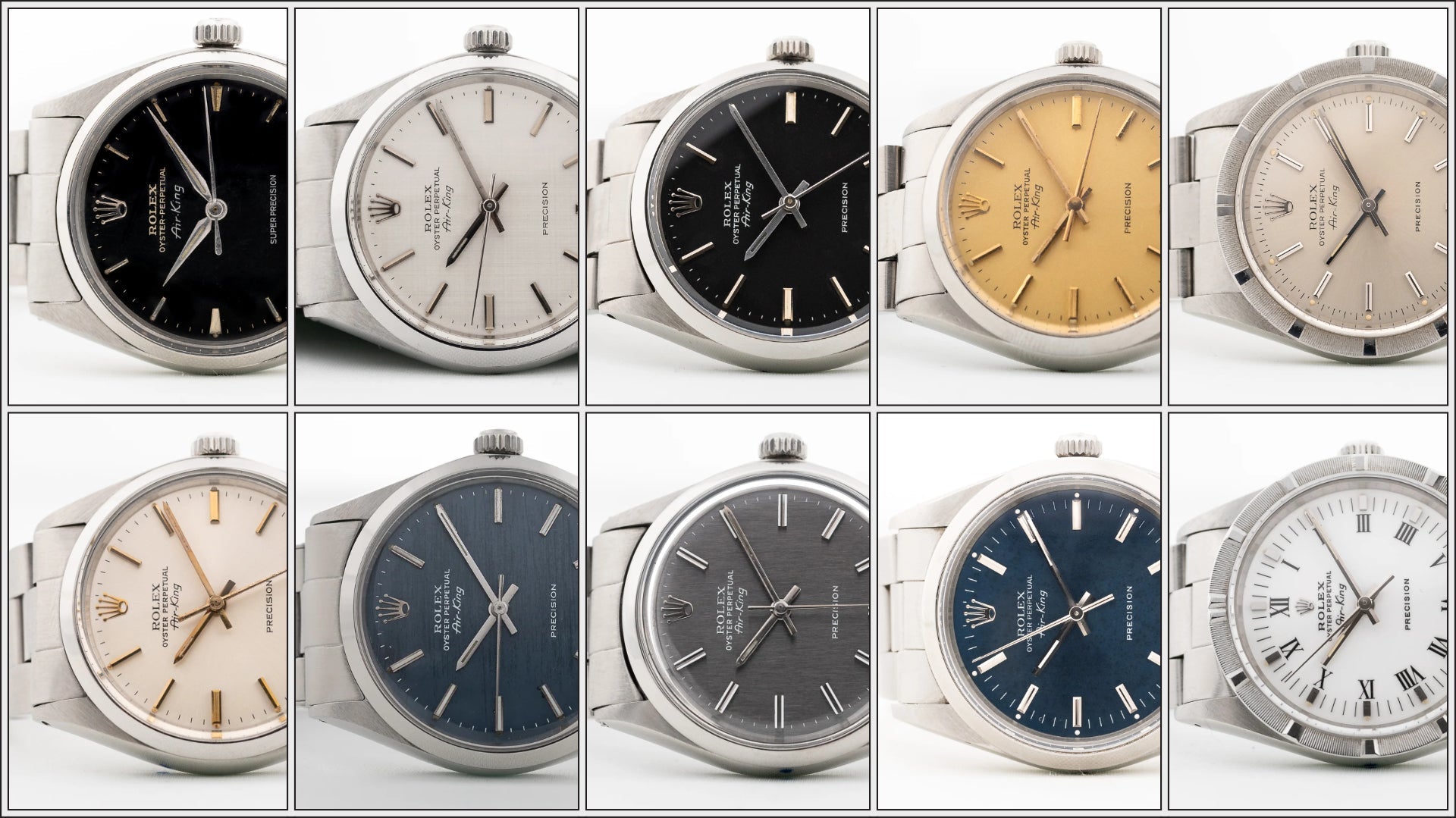
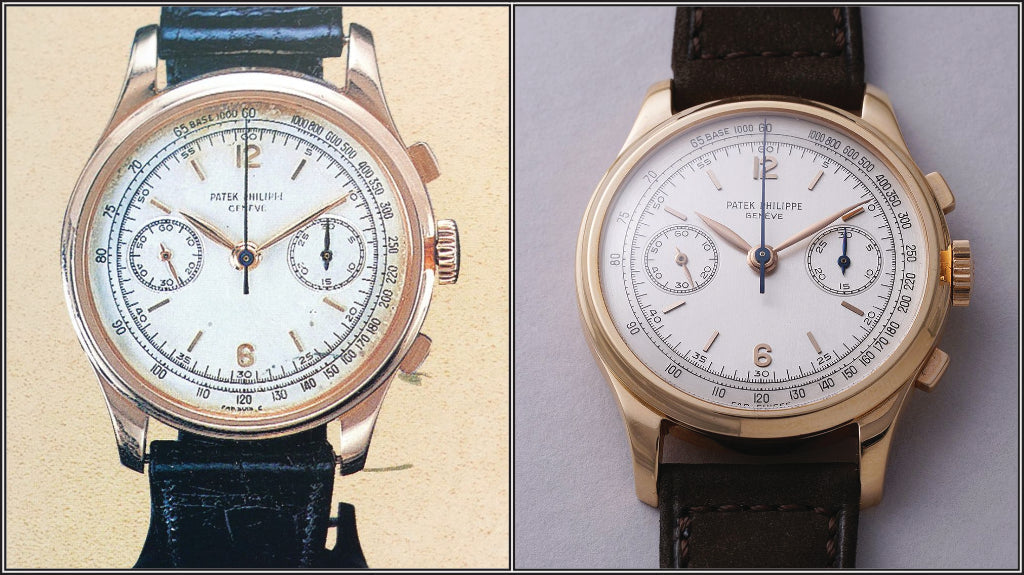
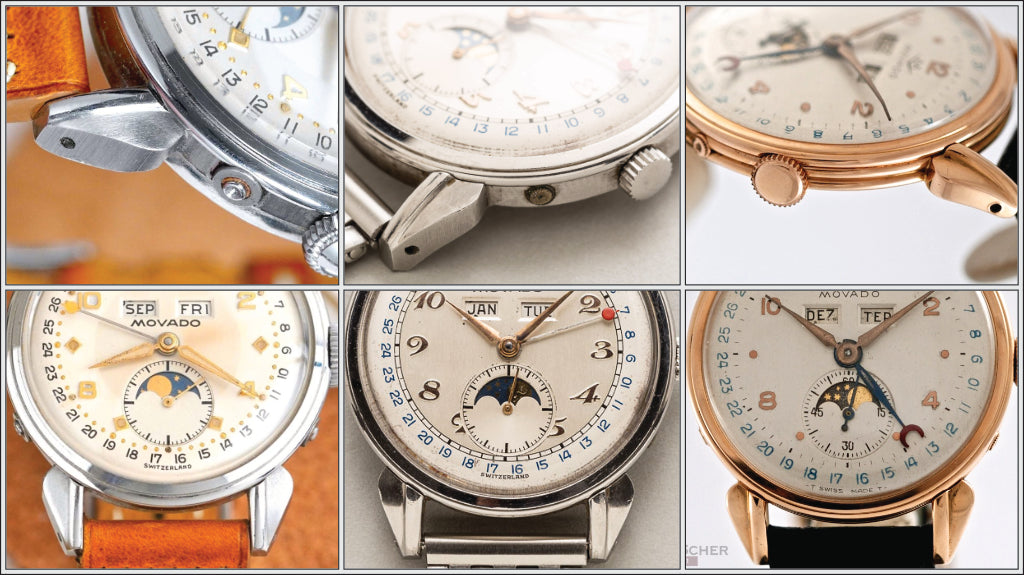



















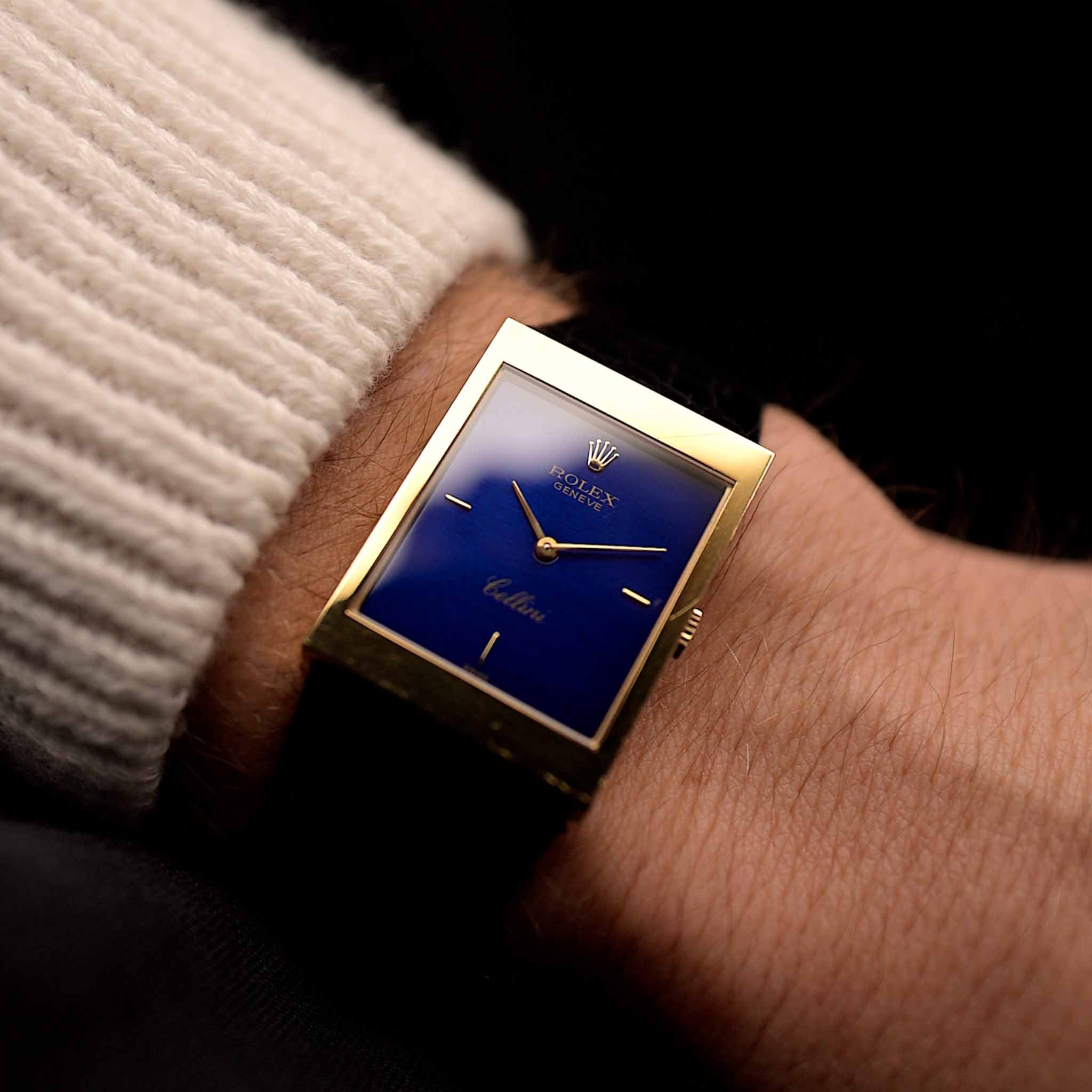
Leave a comment